Cold Plasma Systems and Their Application in Surface Treatments for Medicine
Abstract
1. Introduction
2. Plasmas and Techniques for Their Generation
3. Interaction between Plasmas and Surfaces. Physical and Chemical Processes
3.1. Electron Impact Ionization: e− + A → A+ + 2e−
3.2. Electron Impact Excitation: e− + A → A* + e−
3.3. Electron Impact Dissociation: e− + AB → A+ B + e−
3.4. Ion processes
- Ion-ion
- Ion-molecule
- Radical-radical
- Radical-molecule
- Molecule-molecule
- Surface absorption
- Surface recombination
- Diffusion
- Surface desorption
- Surface reactions
- Surface de-excitation(quenching)
- Film formation
4. Plasma Treatment of Medical Materials
4.1. Enhanced Surface Hydrophilicity and Cell Adhesion
4.2. Plasma Generation of RONs for Medical Treatment
5. Conclusions
Author Contributions
Funding
Conflicts of Interest
References
- Hollahan, J.R.; Stafford, B.B.; Falb, R.D.; Payne, S.T. Attachment of amino groups to polymer surfaces by radiofrequency plasmas. Appl. Polymer 1969, 13, 807–816. [Google Scholar] [CrossRef]
- Wesson, J. Tokamaks, 3rd ed.; Oxford Science Publications, Clarendon Press: Oxford, UK, 2004. [Google Scholar]
- St Braithwaite, N.J. Introduction to gas discharges. Plasma Sour. Sci. Technol. 2000, 9, 517–527. [Google Scholar] [CrossRef]
- Conrads, H.; Schmidt, M. Plasma generation and plasma sources. Plasma Sour. Sci. Technol. 2000, 9, 441–454. [Google Scholar] [CrossRef]
- Lieberman, M.A.; Lichtenberg, A.J. Principles of Plasma Discharges and Materials Processing; Wiley Interscience: Hoboken, NJ, USA, 2005. [Google Scholar]
- Capitelli, M.; Ferreira, C.M.; Gordiets, B.F.; Osipov, A.I. Plasma Kinetics in Atmospheric Gases; Springer: New York, NY, USA, 2000; pp. 66–154. [Google Scholar]
- Bogaerts, A.; Neyts, E.; Gijbels, R.; van der Mullen, J. Gas discharge plasmas and their applications. Spectrochim. Acta Part B 2002, 57, 609M–665M. [Google Scholar] [CrossRef]
- Laroussi, X.L.; Keidar, M. Perspective: The physics, diagnostics, and applications of atmospheric pressure low temperature plasma sources used in plasma medicine. J. Appl. Phys. 2017, 122, 020901. [Google Scholar] [CrossRef]
- Bruggeman, P.J.; Iza, F.; Brandenburg, R. Foundations of atmospheric pressure non-equilibrium plasmas. Plasma Sour. Sci Technol. 2017, 26, 123002. [Google Scholar] [CrossRef]
- Fanelli, F.; Fracassi, F. Atmospheric pressure non-equilibrium plasma jet technology: General features, specificities, and applications in surface processing of materials. Surf. Coat. Technol. 2017, 322, 174–201. [Google Scholar] [CrossRef]
- Merche, D.; Vandencasteele, N.; Reniers, F. Atmospheric plasmas for thin film deposition: A critical review. Thin Solid Films 2012, 520, 4219–4236. [Google Scholar] [CrossRef]
- Bárdos, L.; Baránková, H. Cold atmospheric plasma: Sources, processes, and applications. Thin Solid Films 2010, 518, 6705–671311. [Google Scholar] [CrossRef]
- Tabarés, F.L. Plasma Applications for Material Modification: From Microelectronics to Biological Materials; Jenny Stanford Publishing: Singapore, 2020. [Google Scholar]
- Sherar, A.; Bertuccelli, G.; Di Rocco, H.O. Experimental and numerical study of a pulsed cold discharge. Phys. Scripta 1993, 47, 579–584. [Google Scholar] [CrossRef]
- Cohen, R.S.; Lyman, S., Jr.; McRoutly, P. The electrical conductivity of an ionized gas. Phys. Rev. 1950, 80, 230–238. [Google Scholar] [CrossRef]
- Stangeby, P.C. The Plasma Boundary of Magnetic Fusion Devices. IOP; CRC Press: Boca Raton, FL, USA, 2000; ISBN 0750305592. [Google Scholar]
- Gay-Mimbrera, J.; García, J.; Carmen, M.; Beatriz, I.T.; Serrano, R.; García-Nieto, A.; Vélez, A. Clinical and biological principles of cold atmospheric plasma application in skin cancer. Adv. Ther. 2016, 3, 894–909. [Google Scholar] [CrossRef] [PubMed]
- Gan, L.; Song, Z.; Devesh, P.; Dawei, L.; Xinpei, L.; Mengwen, H.; Xiaoru, D.; Hongxiang, C. Medical applications of nonthermal atmospheric pressure plasma in dermatology. JDDG J. Deutsch. Dermatol. Gesellsch. 2018, 16, 7–13. [Google Scholar] [CrossRef]
- Stancampiano, A.; Forgione, D.; Simoncelli, E.; Laurita, R.; Tonini, R.; Gherardi, M.; Colombo, V. The effect of cold atmospheric plasma (cap) treatment at the adhesive-root dentin interface. J. Adhes. Dent. 2019, 21, 229–237. [Google Scholar]
- Hoffmann, C.; Berganza, C.; Zhang, J. Cold atmospheric plasma: Methods of production and application in dentistry and oncology. Med. Gas Res. 2013, 3, 21. [Google Scholar] [CrossRef] [PubMed]
- Mirpour, S.; Fathollah, S.; Mansouri, P.; Larijani, B.; Ghoranneviss, M.; Tehrani, M.M.; Amini, M.R. Cold atmospheric plasma as an effective method to treat diabetic foot ulcers: A randomized clinical trial. Sci. Rep. 2020, 10, 10440. [Google Scholar] [CrossRef]
- Nguyen, N.H.; Park, N.J.; Yang, S.S.; Choi, K.S.; Lee, J.-S. Anti-cancer efficacy of nonthermal plasma dissolved in a liquid, liquid plasma in heterogeneous cancer cells. Sci. Rep. 2016, 6, 29020. [Google Scholar] [CrossRef]
- Federici, G.; Skinner, C.H.; Brooks, J.N.; Coad, J.P.; Grisolia, C.; Naasz, A.A.; Philipps, V.; Pitcher, C.S.; Roth, J.; Wampler, W.R.; et al. Plasma-material interactions in current tokamaks and their implications for next step fusion reactors. Nucl. Fusion 2001, 41, 1967. [Google Scholar] [CrossRef]
- Roth, J.; Vietzke, E.; Haasz, A. A 1991 atomic and plasma–wall interaction data for fusion. Nucl. Fusion 2001, 9 (Suppl. 1). [Google Scholar]
- Wolf, R.; Sparavigna, A.C. Role of plasma surface treatments on wetting and adhesion. Engineering 2010, 2, 397–402. [Google Scholar] [CrossRef]
- Von Woedtke, T.; Schmidt, A.; Bekeschus, S.; Wende, K.; Weltmann, K.-D. Plasma medicine: A field of applied redox biology. In Vivo 2019, 33, 1011–1026. [Google Scholar] [CrossRef]
- Stratmann, B.; Costea, T.-C.; Nolte, C.; Hiller, J.; Schmidt, J.; Reindel, J.; Masur, K.; Motz, W.; Timm, J.; Kerner, W.; et al. Effect of cold atmospheric plasma therapy vs. standard therapy placebo on wound healing in patients with diabetic foot ulcers: A randomized clinical trial. JAMA Netw. Open 2020, 3, e2010411. [Google Scholar] [CrossRef] [PubMed]
- Tajima, S.; Komvopoulos, K. Effect of reactive species on surface crosslinking of plas-ma-treated polymers investigated by surface force microscopy. Appl. Phys. Lett. 2006, 89, 124102. [Google Scholar] [CrossRef]
- Luque-Agudo, V.; Hierro-Olivia, M.; Gallardo-Moreno, A.M.; Gnzalez-Martin, M.L. Effects of plasma treatment on the surface properties of polylactic acid films. Polymer Test. 2021, 96, 23. [Google Scholar] [CrossRef]
- Jaritz, M.; Behm, H.; Hopmann, C.; Kirchheim, D.; Mitschker, F.; Awakowicz, P.; Dahlmann, R. The effect of UV radiation from oxygen and argon plasma on the adhe-sion of organosilicon coatings on polypropylene. J. Phys. D Appl. Phys. 2017, 50, 9. [Google Scholar] [CrossRef]
- Wertheimer, M.R.; Fozza, A.C.; Hollander, A. Industrial processing of polymers by low-pressure plasmas: The role of VUV radiation. Nucl. Instrum. Methods Phys. Res. B 1999, 151, 65. [Google Scholar] [CrossRef]
- Junkar, I. Chapter two-interaction of cells and platelets with biomaterial surfaces treated with gaseous plasma. In Advances in Biomembranes and Lipid Self-Assembly; Iglič, A., Kulkarni, C.V., Rappolt, M., Eds.; Academic Press: Cambridge, MA, USA, 2016; Volume 23, pp. 25–59. [Google Scholar]
- Richbourg, N.R.; Peppas, N.A.; Sikavitsas, V.I. Tuning the biomimetic behavior of scaffolds for regenerative medicine through surface modifications. J. Tissue Eng. Regenerat. Med. 2019, 13, 1275–1293. [Google Scholar] [CrossRef]
- Badv, M.; Bayat, F.; Weitz, J.I.; Didar, T.F. Single and multi-functional coating strategies for enhancing the biocompatibility and tissue integration of blood-contacting medical implants. Biomaterials 2020, 258, 120291. [Google Scholar] [CrossRef]
- Qiu, X.; Lee, B.L.-P.; Ning, X.; Murthy, N.; Dong, N.; Li, S. End-point immobilization of heparin on plasma-treated surface of electrospun polycarbonate-urethane vascular graft. Acta Biomater. 2017, 51, 138–147. [Google Scholar] [CrossRef]
- Hegemann, D.; Brunner, H.; Oehr, C. Plasma treatment of polymers for Surface and adhesion improvement. Nucl. Instr. Meth. Phys. Res. B 2003, 208, 281–286. [Google Scholar] [CrossRef]
- Junkar, A. Plasma treatment of amorphous and semicrystalline polymers for improved biocompatibility. Vacuum 2013, 98, 111–115. [Google Scholar] [CrossRef]
- Modic, M.; Junkar, I.; Vesel, A.; Mozetič, M. Aging of plasma treated surfaces and their effects on platelet adhesion and activation. Surf. Coat. Technol. 2012, 213, 98–104. [Google Scholar] [CrossRef]
- Ozaltin, K.; Lehocky, M.; Kucekova, Z.; Humpolicek, P.; Saha, P. A novel multistep method for chondroitin sulphate immobilization and its interaction with fibroblast cells. Mater. Sci. Eng. C 2017, 70, 94–100. [Google Scholar] [CrossRef]
- Popelka, B. Antimicrobial modification of PLA scaffolds with ascorbic and fumaric acids via plasma treatment. Surf. Coat. Technol. 2020, 400, 126216. [Google Scholar] [CrossRef]
- Tasiopoulos, P. Surface functionalization of PTFE membranes intended for guided bone regeneration using recombinant spider silk. ACS Appl. Bio Mater. 2020, 3, 577–583. [Google Scholar] [CrossRef]
- Chevallier, P.; Janvier, R.; Mantovani, D.; Laroche, G. In vitro biological performances of phosphorylcholine-grafted ePTFE prostheses through RFGD plasma techniques. Macromol. Biosci. 2005, 5, 829–839. [Google Scholar] [CrossRef] [PubMed]
- Ahn, H.J.; Kim, K.I.; Hoan, N.N.; Kim, C.H.; Moon, E.; Choi, K.S.; Yang, S.S.; Lee, J.-S. Targeting cancer cells with reactive oxygen and nitrogen species generated by atmospheric- pressure air plasma. PLoS ONE 2014, 9. [Google Scholar] [CrossRef] [PubMed]
- Turrini, E.; Laurita, R.; Stancampiano, A.; Catanzaro, E.; Calcabrini, C.; Maffei, F.; Gherardi, M.; Colombo, V.; Fimognari, C. Cold atmospheric plasma induces apoptosis and oxidative stress pathway regulation in T-lymphoblastoid leukemia cells. Oxid. Med. Cell. Longev. 2017, 13, 4271065. [Google Scholar] [CrossRef] [PubMed]
- Mitra, S.; Nguyen, L.N.; Akter, M.; Park, G.; Choi, E.H.; Kaushik, N.K. Impact of ROS generated by chemical, physical, and plasma techniques on cancer attenuation. Cancers 2019, 11, 1030. [Google Scholar] [CrossRef]
- Ellerweg, D.; Benedikt, J.; von Keudell, A.; Knake, N.; Gathen von der Schulz Gathen, V. Characterization of the effluent of a He/O2 mi-croscale atmospheric pressure plasma jet by quantitative molecular beam mass spectrometry. New J. Phys. 2010, 12, 013021. [Google Scholar] [CrossRef]
- Zhang, S.; van Gaens, W.; van Gressel, B.; Hofman, S.; van Veldhuizen, E.; Bogaerts, A.; Bruggeman, P. Model predictions of chemi-cal species as a function of distance from an Ar/O2 plasma jet tip. J. Phys. D 2013, 46, 205202. [Google Scholar] [CrossRef]
- Cejas, E.; Mancinelli, B.; Prevosto, L. Modelling of an atmospheric–pressure air glow discharge operating in high–gas temperature regimes: The role of the associative ionization reactions involving excited atoms. Plasma 2020, 3, 12–26. [Google Scholar] [CrossRef]
- He, Y.; Kemaneci, E.; Brinkmann, R.P. International Online Plasma Seminar. Available online: https://mipse.umich.edu/online_seminars.php (accessed on 3 December 2020).
- Guerra, V.; Tejero del Caz, A.; Pintassilgo, C.D.; Alves, L.L. Topical review: Modelling N2O2 plasmas. Plasma Sour. Sci. Technol. 2019, 28, 073001. [Google Scholar] [CrossRef]
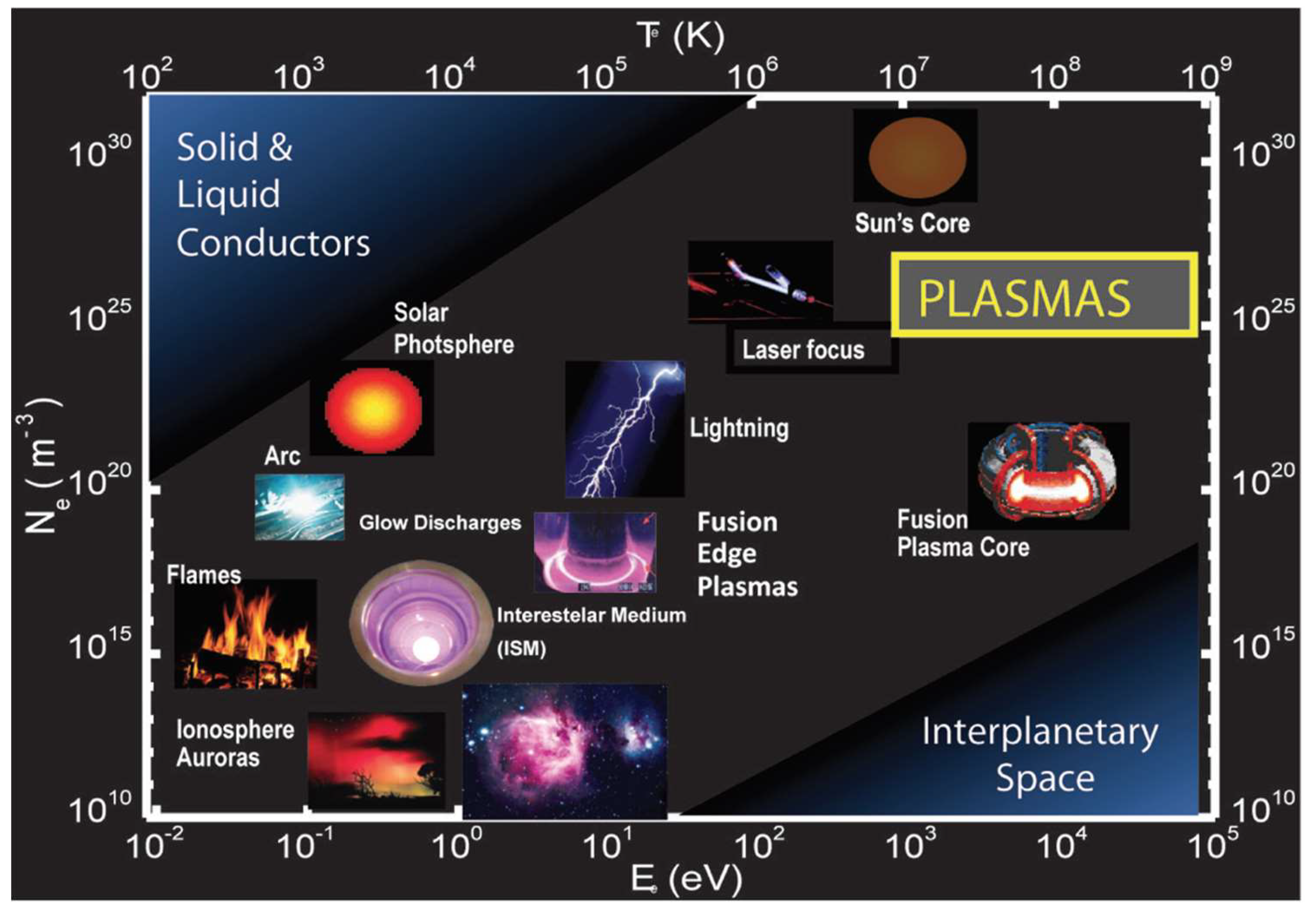
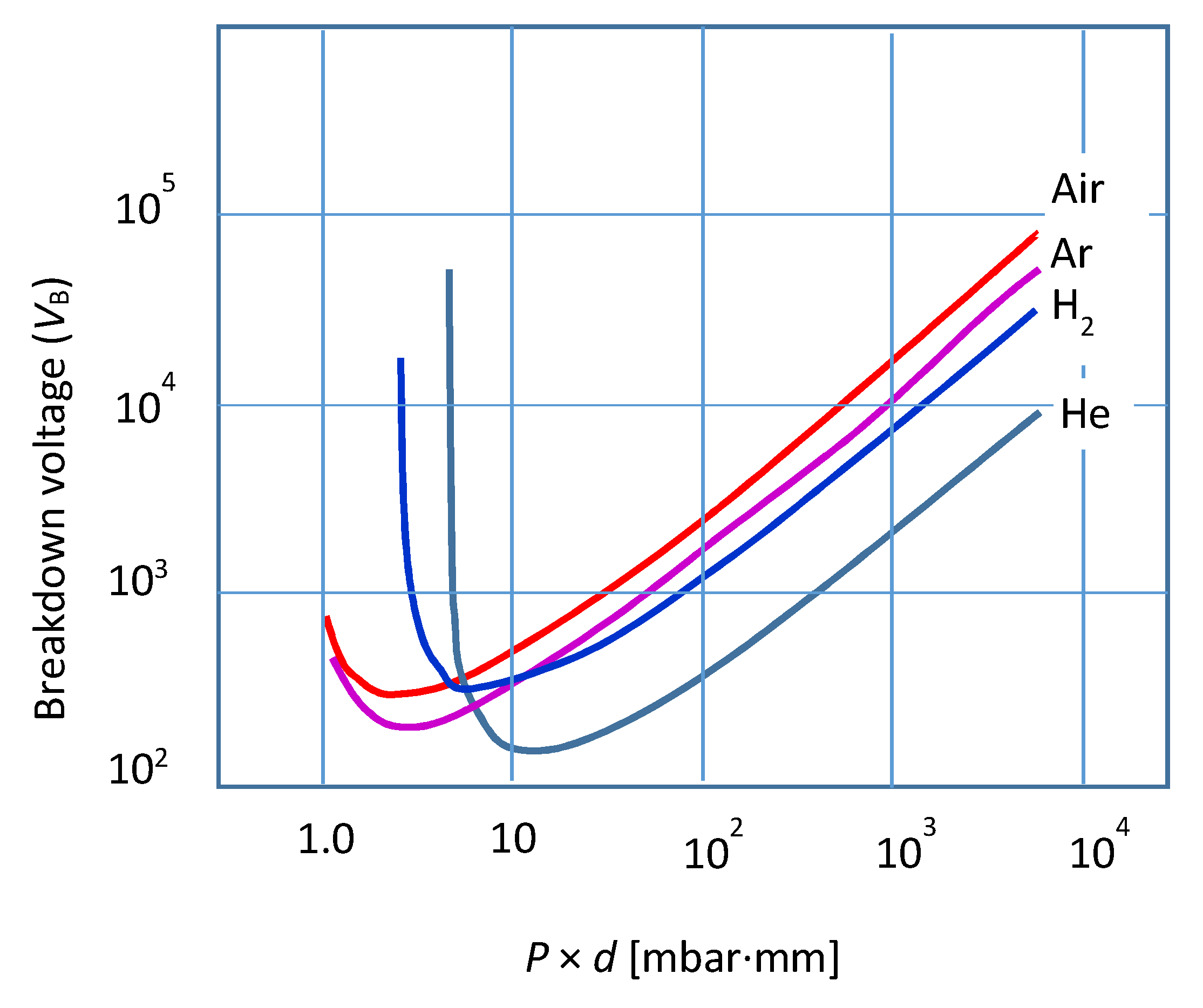

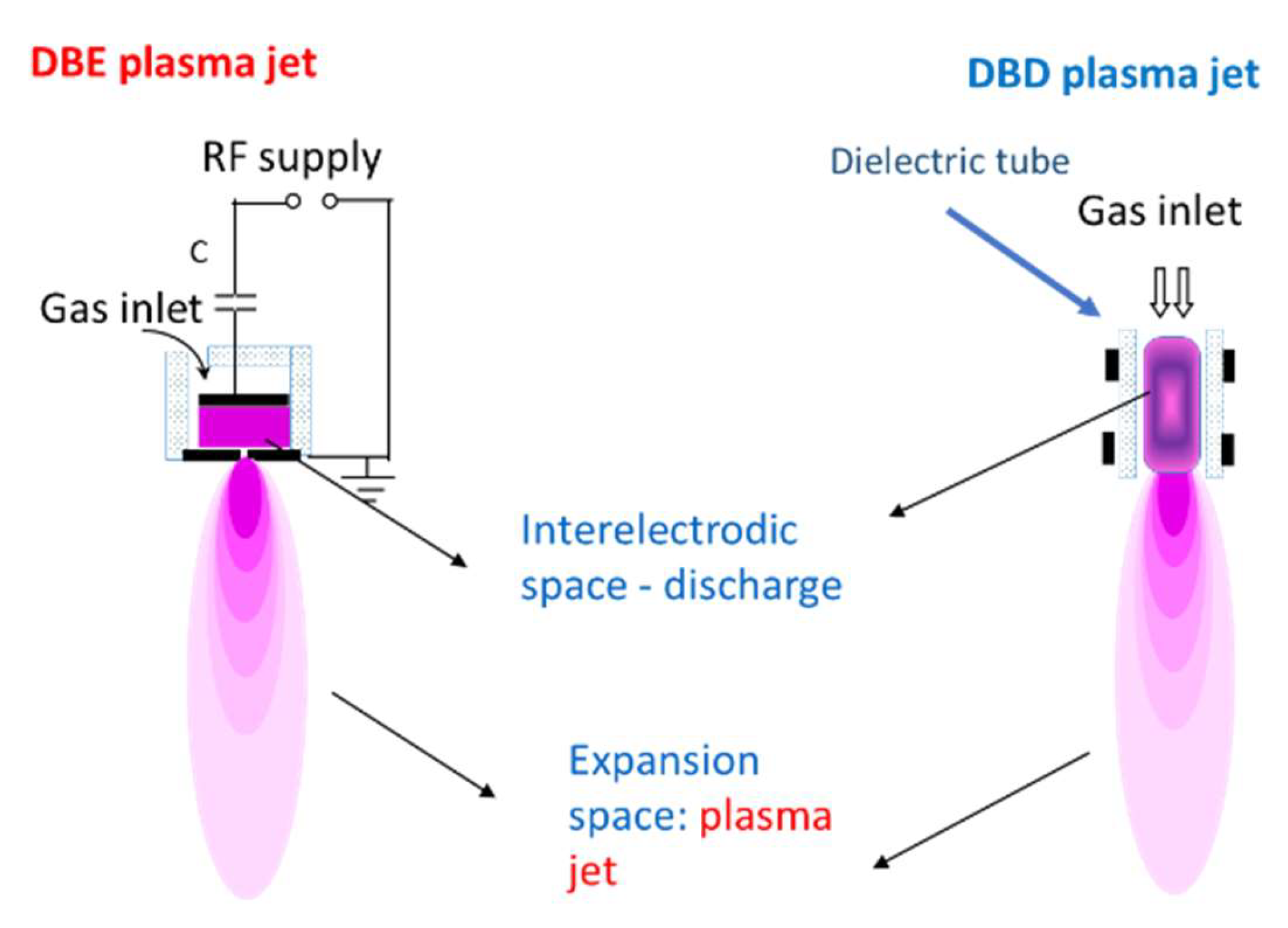
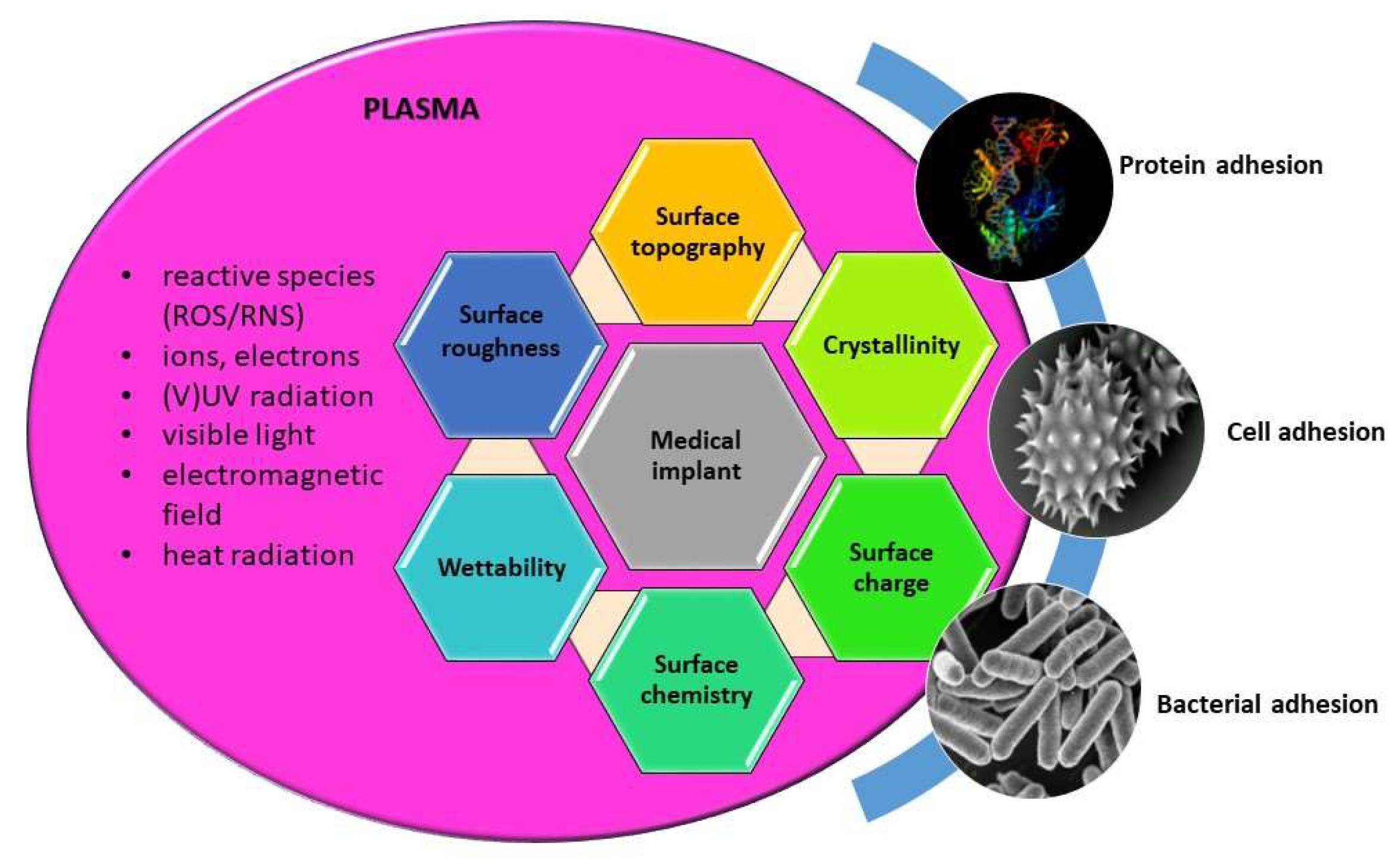
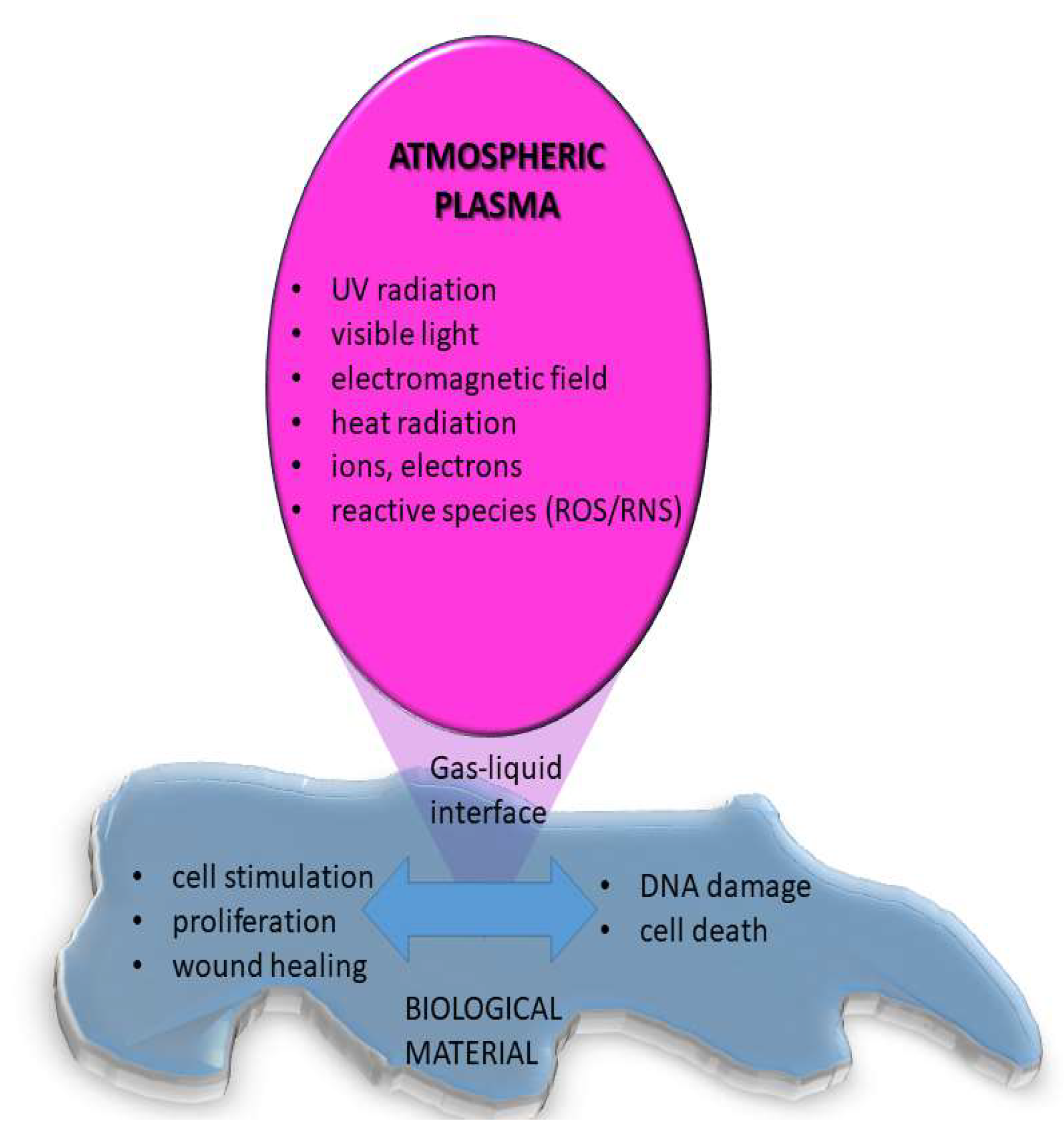

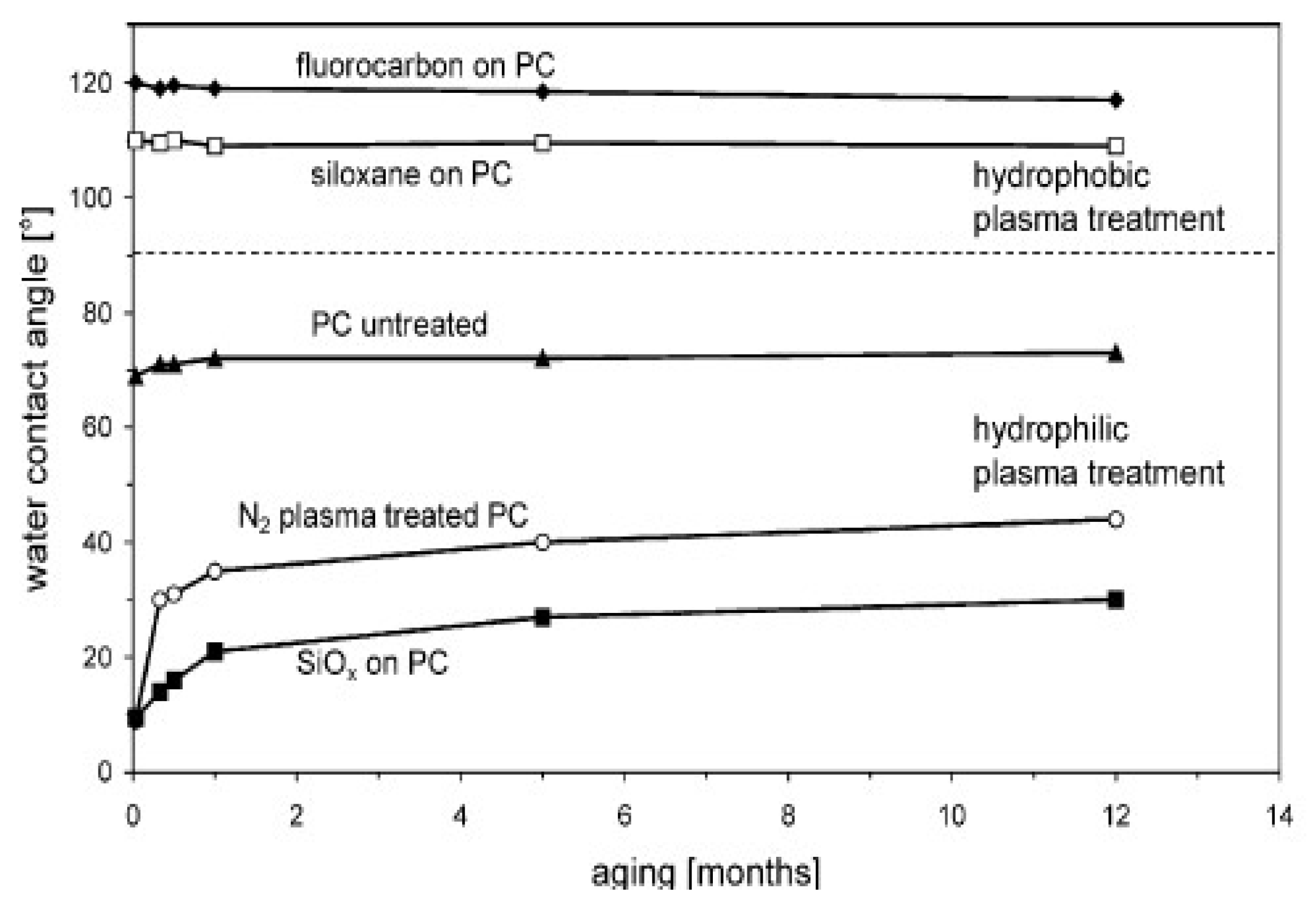
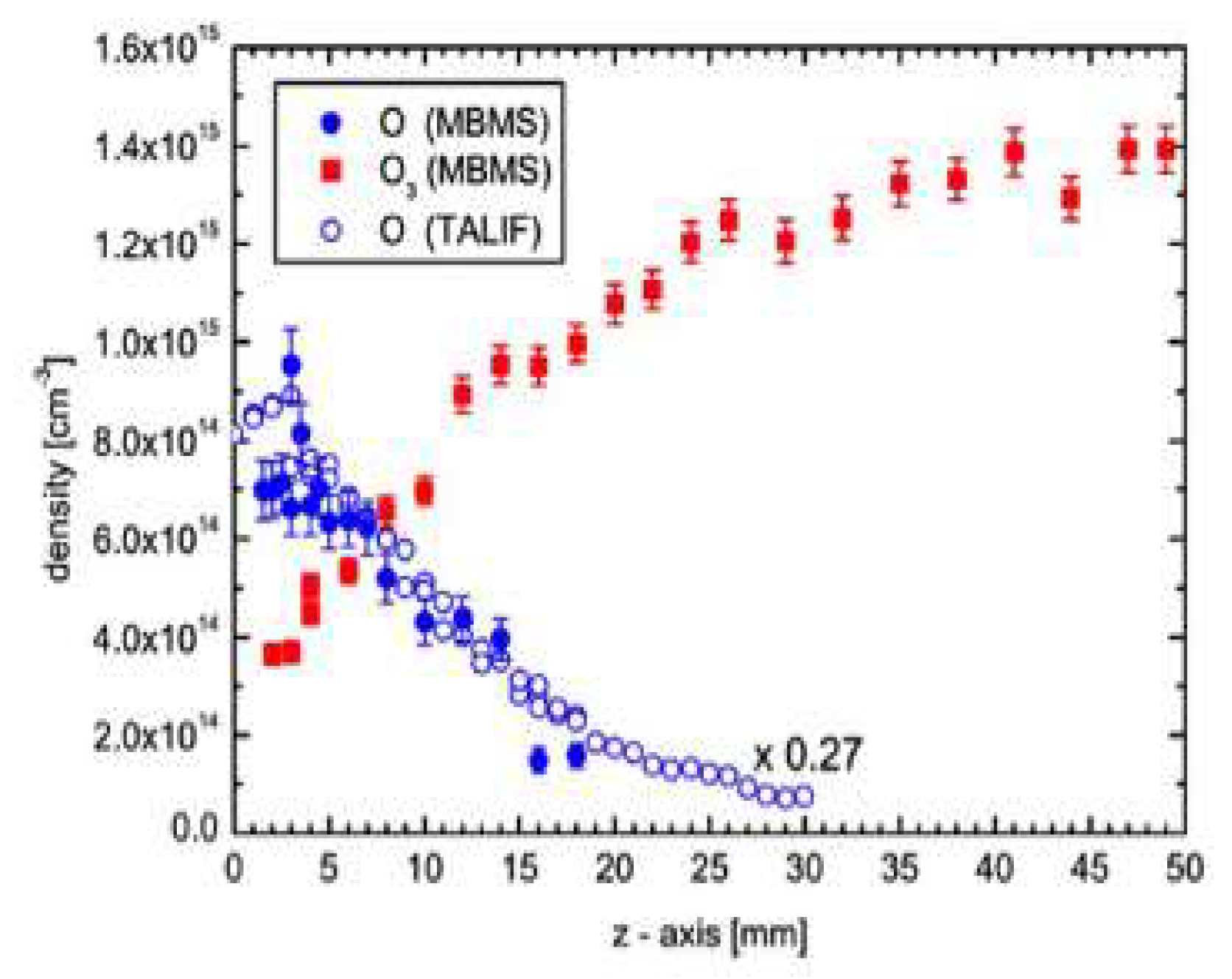
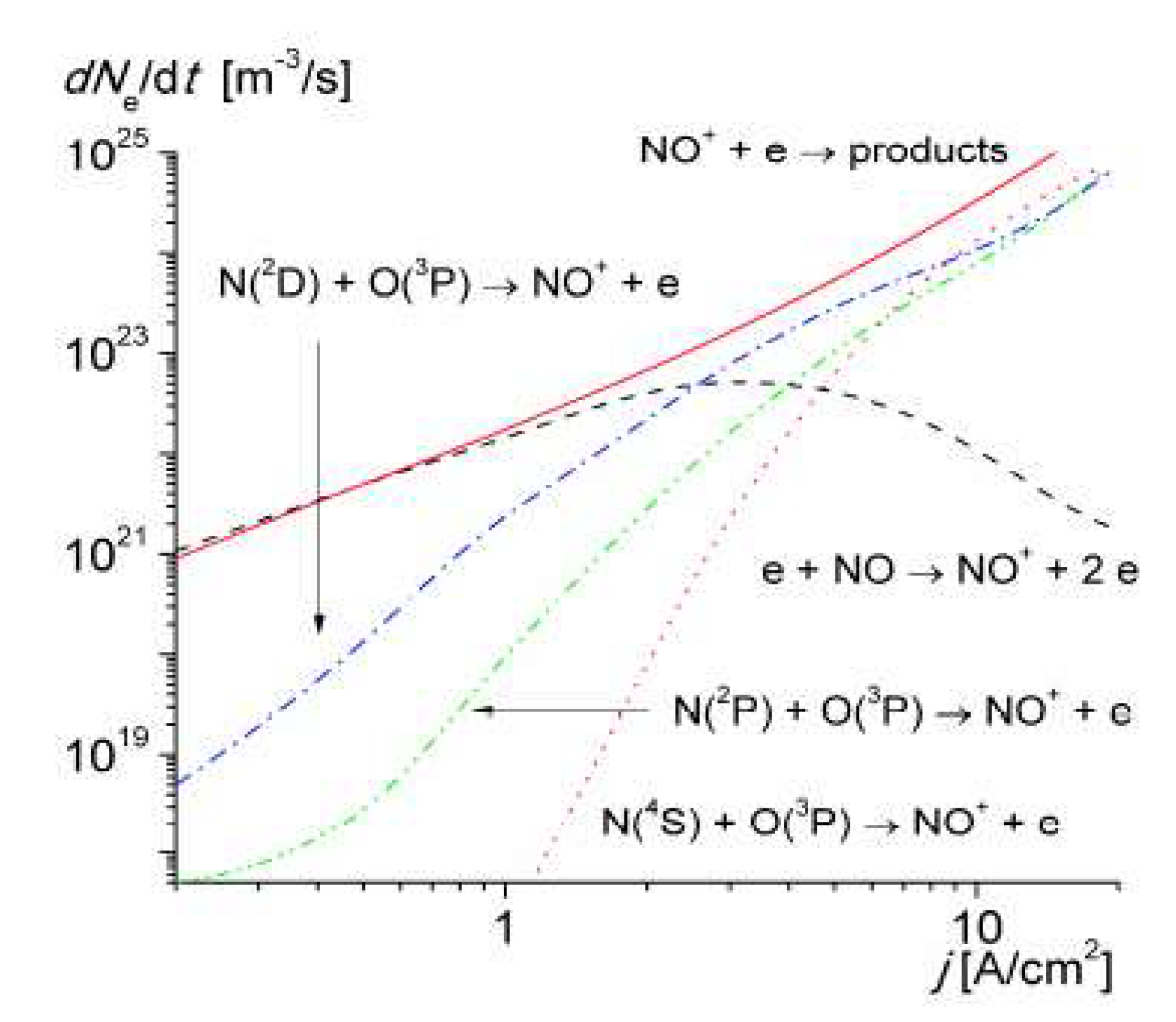
Publisher’s Note: MDPI stays neutral with regard to jurisdictional claims in published maps and institutional affiliations. |
© 2021 by the authors. Licensee MDPI, Basel, Switzerland. This article is an open access article distributed under the terms and conditions of the Creative Commons Attribution (CC BY) license (http://creativecommons.org/licenses/by/4.0/).
Share and Cite
Tabares, F.L.; Junkar, I. Cold Plasma Systems and Their Application in Surface Treatments for Medicine. Molecules 2021, 26, 1903. https://doi.org/10.3390/molecules26071903
Tabares FL, Junkar I. Cold Plasma Systems and Their Application in Surface Treatments for Medicine. Molecules. 2021; 26(7):1903. https://doi.org/10.3390/molecules26071903
Chicago/Turabian StyleTabares, Francisco L., and Ita Junkar. 2021. "Cold Plasma Systems and Their Application in Surface Treatments for Medicine" Molecules 26, no. 7: 1903. https://doi.org/10.3390/molecules26071903
APA StyleTabares, F. L., & Junkar, I. (2021). Cold Plasma Systems and Their Application in Surface Treatments for Medicine. Molecules, 26(7), 1903. https://doi.org/10.3390/molecules26071903






